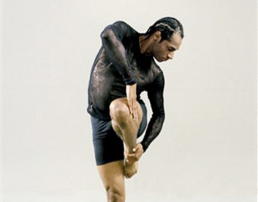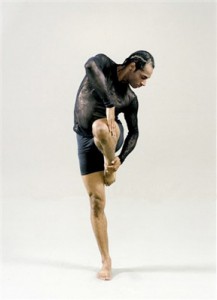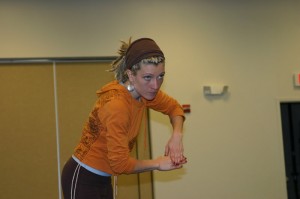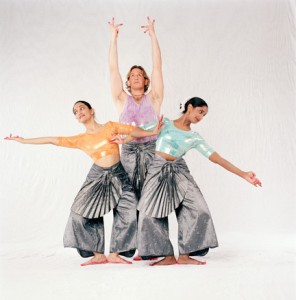The Youth Dance Ensemble (YDE) is Joy of Motion Dance Center’s elite program for the developing young dancer, consisting of Senior and Junior level companies and preparatory levels for 1st through 8th graders. This pre-collegiate program, includes core classes in ballet, jazz and modern dance, plus additional dance forms, dance history, improvisation and composition, artist residencies and numerous performance opportunities. The curriculum is guided by the National Dance Education Organization’s Standards for Learning and Teaching. I consider our program to be a benchmark for excellence in teaching dance to youth. Yet we still face considerable difficulties, many of which are similar to the difficulties faced by all youth dance programs, and teachers.
This past year has been stellar for the Youth Dance Ensemble. In September of 2006 the young dancers were honored at the Metro DC Dance Awards with the Most Outstanding Youth Performance of 2006 for their May concert at the Jack Guidone Theater. In April, the Youth Dance Ensemble will take the Kennedy Center’s Millennium Stage, and in May they will perform at The ARC in Dance Place’s annual Youth Dance Festival. Their performances calendar concludes with a full concert at Joy of Motion’s Jack Guidone Theater in May. Directing this program has brought me tremendous joy over the last several years. It has also brought challenges and frustrations.
Dealing with limited workable studio space is a never-ending issue that dance educators continuously face. In December of 2005 Joy of Motion Dance Center’s Bethesda location closed its doors on Woodmont Avenue, as the building had been sold (to make room for high-end condominiums and higher-end retail.) The Maryland Youth Ballet was housed in the same building and was left with no home, as well. JOMDC’s new location was not yet ready for occupancy, and the YDE program was displaced. Our temporary home was JOM- Friendship Heights, but due to time and space restrictions at that location, classes were combined. The Senior Company was combined with the Junior Company for a portion of the day. Then the Senior Company students left and the Junior Company was joined by the preparatory levels for the second class. On Wednesdays, all levels of students were combined, giving us an hour and a half class with 26 students, ranging in age from 7-18. Youth Dance Ensemble educators were all present and participated in ‘team teaching.’ Nevertheless, the very real question arose: “What in the world am I going to do with 26 kids who are all different ages and different levels in the same class?”
This is the question that kept me awake at night as we moved towards the date that this schedule would be in effect. The problem of mixed age/ability classrooms is one that many dance teachers have experienced, and there is no easy solution. Some of the faculty had a great deal of experience working with younger children, but no experience with teenagers. Others, including myself, were used to working with teens and adults but had rarely taught students in grade school. Additionally, JOMDC borrowed space from Chevy Chase Ballroom during this time to help accommodate our need for more space. The surface of a ballroom dance floor is similar to being on an ice skating rink. Teaching technique classes became almost impossible and we were forced to work in a more improvisationally-based manner.
It was during this time that I created the dance, “Joyful Motion” for the entire Youth Dance Ensemble. Douglas Yeuell, Executive/Artistic Director at Joy of Motion Dance Center, composed a beautiful piece of music for this project and I began to work. Base phrase material was created and taught to the older students. Younger students were paired with older students and created their own duets and trios from the ‘base phrase material.’ The faculty learned different sections and were responsible for helping the students retain the choreography. Young dancers experienced being lifted for the first time and older students learned the true meaning of being a ‘role model.’ This was such a wonderful learning experience for me and the other teachers, as well, as few of us had any experience working with multiple teachers at the same time. What we discovered is that people learn from example, rather than by instruction. The students watched their educators come together and be a part of creating something special. In turn, the students worked together, helped each other and truly created something magical…..a dance that was so much greater than the sum of its parts. One of the lessons learned was that with conscious and creative action a hardship (lack of studio space, combined classes) can become an inspiration.
“Joyful Motion” has become the signature piece for Joy of Motion’s Dance Center’s Youth Dance Ensemble. In the end, the experience was one of the most enriching and satisfying things I have ever done. When I watch the students’ rehearse/perform the work, I am deeply touched, as each of the dancers brings their genuine self to every step. I believe that the difficulties we endured brought out the best in each one of us. I also believe that we will be asked to address the issue of studio space in the future. The DC Metro area continues to be developed, pushing out lower-earning businesses – including dance/art programming. As a dance community, we must strive to find creative solutions.
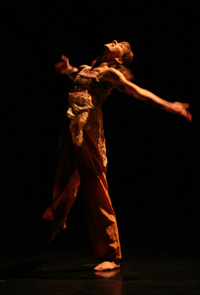 Helen Hayes graduated from the University of MD with a degree in Dance. She has danced professionally with the Maryland Dance Theater, Perlo/Bloom and Co., Cathy Paine and Friends and Dupont Alley Dance Co. Touring internationally, she has been featured on Good Morning, Hong Kong. She has also performed at the Kennedy Center, including the Honors Gala in tribute to Chita Rivera and in New York City. In 1996, she co-founded CrossCurrents Dance Company (in residence at JOMDC) and has served as co- Artistic director for the past decade. Ms. Hayes is an instructor of both modern and jazz dance and has taught extensively throughout the metropolitan area. In 2005, she was a Metro DC Dance Award finalist for Excellence in Dance Education. Currently, she is the Director of the Metro DC Dance Award winning Youth Dance Ensemble at Joy of Motion Dance Center. She spent the summer of 2002 teaching jazz and modern in Varna, Bulgaria at the International Ballet Competition. She is also on the faculty at the University of Maryland.
Helen Hayes graduated from the University of MD with a degree in Dance. She has danced professionally with the Maryland Dance Theater, Perlo/Bloom and Co., Cathy Paine and Friends and Dupont Alley Dance Co. Touring internationally, she has been featured on Good Morning, Hong Kong. She has also performed at the Kennedy Center, including the Honors Gala in tribute to Chita Rivera and in New York City. In 1996, she co-founded CrossCurrents Dance Company (in residence at JOMDC) and has served as co- Artistic director for the past decade. Ms. Hayes is an instructor of both modern and jazz dance and has taught extensively throughout the metropolitan area. In 2005, she was a Metro DC Dance Award finalist for Excellence in Dance Education. Currently, she is the Director of the Metro DC Dance Award winning Youth Dance Ensemble at Joy of Motion Dance Center. She spent the summer of 2002 teaching jazz and modern in Varna, Bulgaria at the International Ballet Competition. She is also on the faculty at the University of Maryland.
